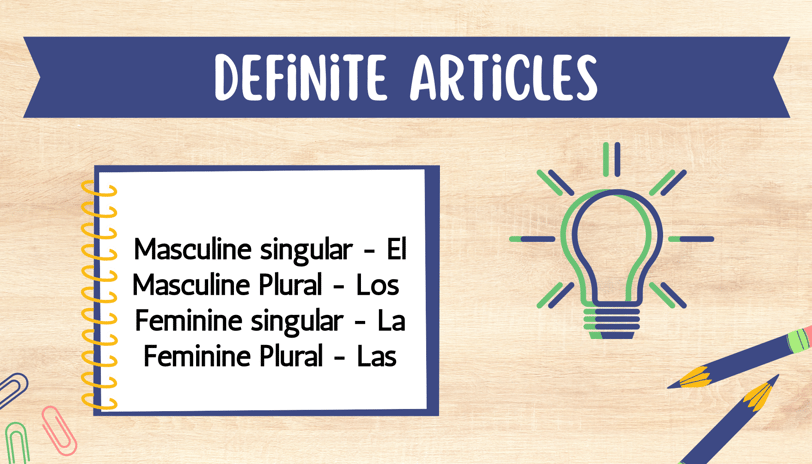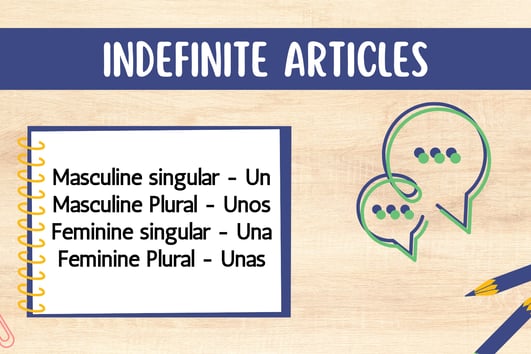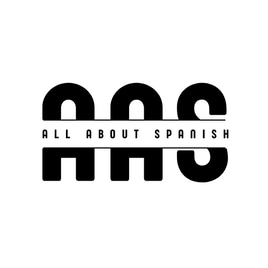START YOUR SPANISH LEARNING JOURNEY
ARTICLES IN SPANISH - Los Artículos
Articles Los Artículos comes before noun to draw special attention to it. The two different types of articles are definite and indefinite articles. The type of article shows the way the speaker is talking about the noun. They could be talking about it in a general sense or as a specific thing.
1/1/20253 min read


DEFINITE ARTICLES
For Spanish beginner students it is a bit confusing to learn Spanish definite articles, because it has to agree with the noun it precedes in gender and number, and an article in other languages doesn’t always correspond to it in Spanish.
For me, it helps to remember that in Spanish there is virtually always an article (either definite or indefinite article) in front of noun (name, place or things), unless you have to use a possessive adjective (my, your, etc.) or a demonstrative adjective (this, that). It is also important that when you’re learning new vocabulary, you make sure that you learn the gender of each noun because the articles as well as pronouns, adjectives, and just everything else in a sentence also change according to the gender of the noun.
In English, ‘the’ is the only definite article. But in Spanish, there are 4 definite articles (artículos defenidos) ‘el ,la ,los ,las’. They specify which place, person or object the speaker is talking about i.e., indicates a specific noun.
Definite articles are -
Placed with countable and uncountable nouns
comes directly in front of a noun or an adjective + noun
placed according to the noun in gender and number
with certain prepositions they may need to contract
Let’s look at some of the examples.
Por ejemplo…
El niño juega con la pelota.( The boy plays with a ball. )
Los estudiantes están en la clase. ( The students are in the class.)
La niña tiene el pelo corto y marron. (The girl has short and brown hair.)
Contrarily, in Spanish the definite articles are also used to indicate the general sense of a noun. The article in English is not used in this sense.
Por ejemplo…
Me gusta el té. (I like tea.)
¡Así es la vida!( That’s life!)
The masculine singular definite article 'el' changes when it precede the preposition "a or de" : the preposition and article become a single word but with other articles it remains the same.
With preposition 'a' + article 'el' = it becomes 'al'
With preposition 'de' + article 'el' = it becomes 'del'
But with la, lasand los it becomes a la/ de la, a las/ de las and a los/ de los.
Por Ejemplo :
Vamos al teatro. (Let's go to the theatre.)
Tienes la comida del perro? (Do you have the dog's food?)
INDEFINITE ARTICLES
The indefinite article (un, una, unos, unas) indicates an unspecific or unidentified noun. In English a, an are the only indefinite nouns, but in Spanish there are four.
Por ejemplo…
Veo a una gata y a un mono. (I see a cat and a monkey.)
Alberto tiene una idea. (Alberto has an idea.)
Characteristics of the indefinite articles:
Used with countable nouns (as opposed to uncountable nouns like water).
Placed in front of an adjective + noun or directly in front of a noun.
Agrees with the noun sometimes in gender and in number.
There are two singular indefinite articles, any of which can mean or be used as “a, an, or one”:
Masculine: un
Feminine: una
Likewise, there are two plural indefinite articles both of them mean "some":
Masculine plural: unos
Feminine plural: unas
Uses of indefinite articles:-
Indefinite articles can be used in front of any unnamed, any unidentified, or unspecified countable nouns.
Por ejemplo…
Hay un problema. (There’s a problem. (What problem?)
Una turista se perdió. A tourist got lost. (Who?)
The singlular indefinite article (un and una) can refer to just ‘one of something’.
Por ejemplo…
Hay una chica en la clase. (There is one girl in the classroom.)
Tengo solamente un hermano. (I only have one brother.)
The plural indefinite article (unos and unas) mean "some":
Por ejemplo…
Compré unas manzanas. (I bought some apples.)
Quiero unos boligrafos. (I want some pens.)
When referring to a person’s profession, the indefinite article is not used in Spanish, although it is used in English.
Por ejemplo…
Soy profesora. (I am a teacher.)
Ana es médica. (Ana is a doctor.)
Roberto quiere ser policía. (Roberto wants to be a policeman.)


